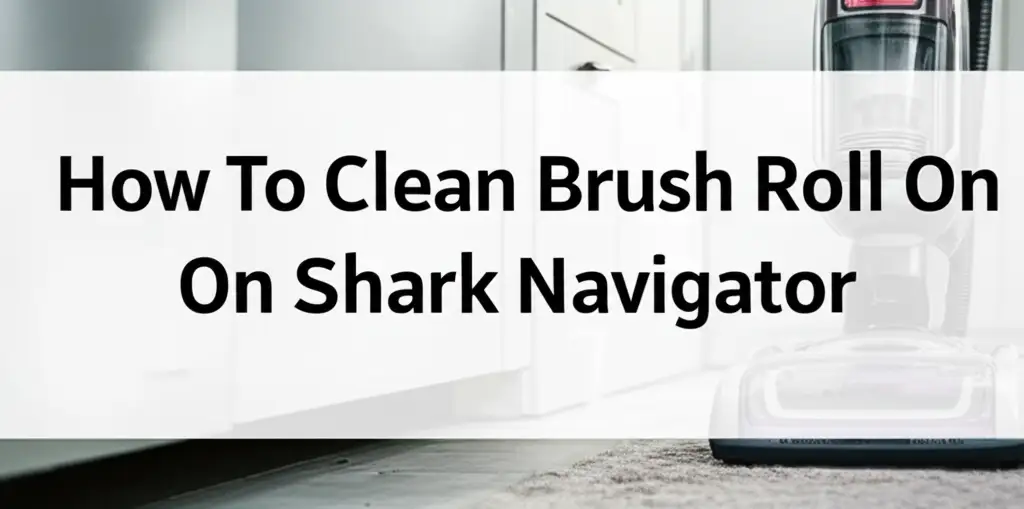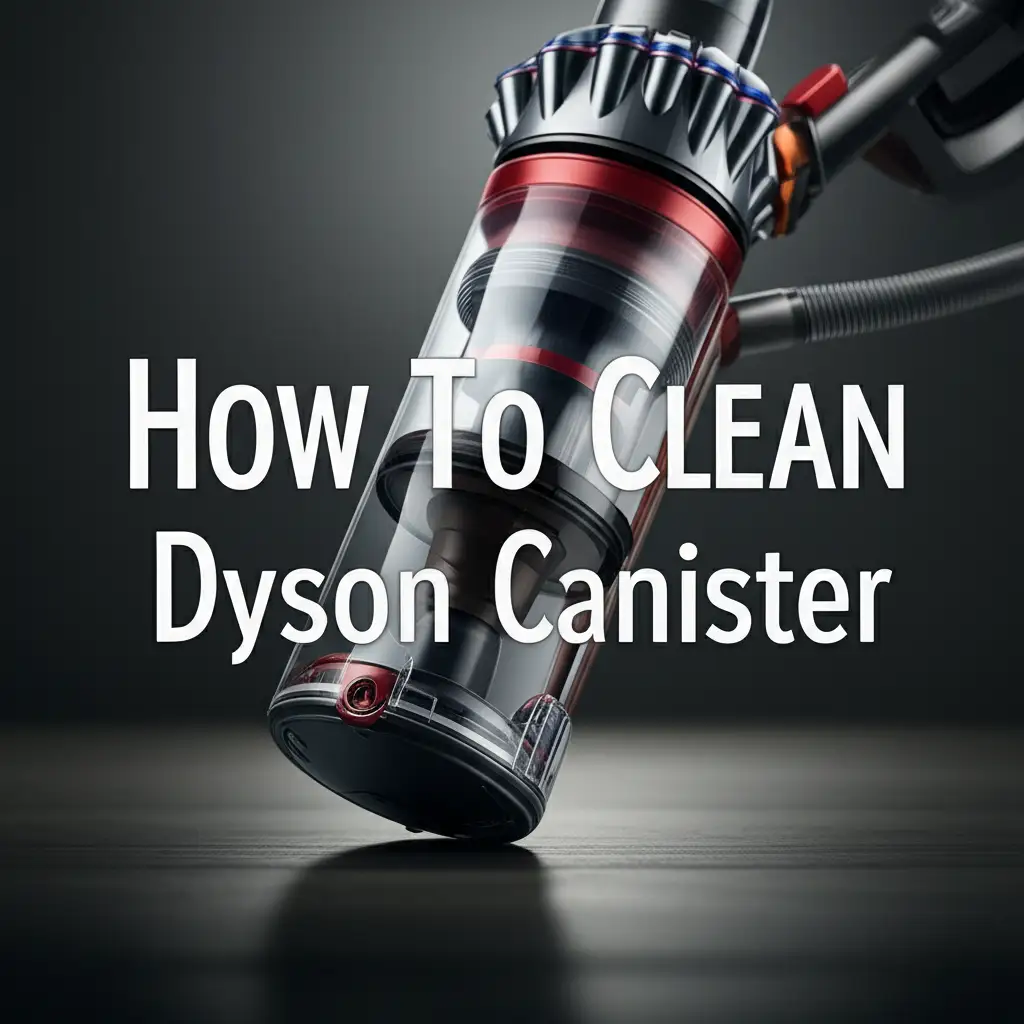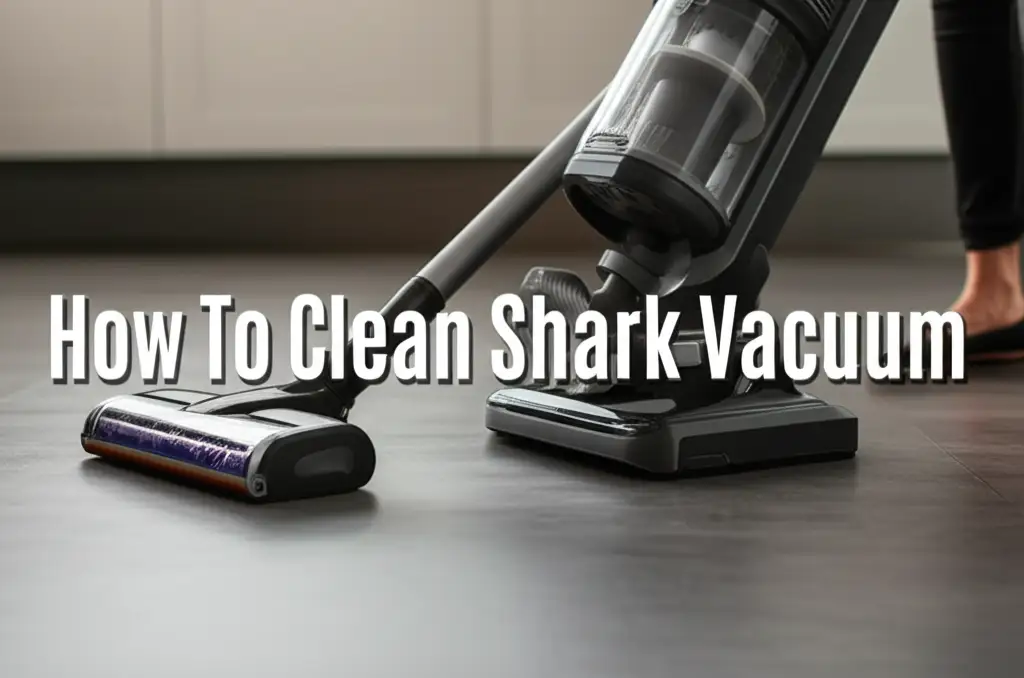· Home Cleaning · 16 min read
How To Clean Brush Roll On Shark Navigator

Keep Your Shark Navigator Running Smooth: How to Clean the Brush Roll
A clean home feels great. My Shark Navigator vacuum is a key tool in achieving that feeling. However, even the best vacuums need some care. The brush roll on your Shark Navigator can collect a lot of hair, string, and debris. This buildup causes problems. It reduces suction and harms cleaning performance. You will notice your vacuum is not picking up dirt like it used to.
Cleaning the brush roll is a simple task. It makes a big difference in how your vacuum works. I will guide you through each step. This article covers why brush roll cleaning is important. It also lists the tools you need. We will go through accessing the brush roll. Then, we will detail how to remove tangled hair and deeply clean the component. Finally, you will learn how to put everything back together. Get ready to restore your Shark Navigator’s cleaning power.
Takeaway
Regular brush roll cleaning restores your Shark Navigator’s suction. This improves vacuum performance greatly. Always unplug your vacuum before cleaning the brush roll. Cut away tangled hair and debris carefully. Deep clean with a damp cloth if needed.
To clean the brush roll on your Shark Navigator, first unplug the vacuum. Lay the vacuum flat and open the brush roll access panel. Use scissors or a seam ripper to carefully cut and remove tangled hair, string, and debris from the bristles. Wipe the brush roll clean. Then, reassemble the vacuum.
Why Cleaning Your Shark Navigator Brush Roll Matters
Your Shark Navigator works hard to keep floors clean. Its brush roll spins at high speed. This spinning action lifts dirt and debris from carpets and hard floors. Over time, hair, pet fur, threads, and other small items wrap around the brush roll. This buildup is not just cosmetic. It causes real issues for your vacuum cleaner.
First, performance drops. A tangled brush roll cannot spin freely. This means it cannot agitate carpet fibers effectively. It struggles to pick up dirt. Your vacuum loses its ability to clean thoroughly. You might find yourself going over the same spot multiple times. This wastes your time and energy.
Second, it puts strain on the motor. When the brush roll is wrapped in debris, the motor works harder. It tries to force the brush to spin. This extra effort can cause the motor to overheat. Overheating can lead to premature wear and tear. In some cases, it can even cause the vacuum to shut down. This shortens the lifespan of your appliance.
Third, a dirty brush roll can spread dirt. Instead of picking up dirt, the brush roll might push it around. It can leave trails of hair or dust on your floor. This makes your cleaning efforts less effective. You want your vacuum to make your home cleaner, not dirtier. Regular cleaning prevents this problem. It keeps your Shark Navigator working at its best. It extends the life of your valuable cleaning tool.
Essential Tools for Brush Roll Cleaning
Cleaning your Shark Navigator brush roll does not require many special tools. Most items you might already have around your home. Gathering them before you start makes the process smooth. Having the right tools ensures safety and efficiency. This also prevents damage to your vacuum.
First, you will need a pair of scissors. Small, sharp scissors work best for this task. They allow you to cut through stubborn tangles of hair and thread. Larger scissors can be difficult to maneuver around the brush roll bristles. Many people find a seam ripper even better. Its sharp point and small blade allow precise cuts. It slides easily under tightly wound hair. This tool minimizes the risk of cutting the bristles themselves.
Next, consider wearing gloves. Disposable or reusable gloves protect your hands. The brush roll can be dirty, greasy, and covered in dust. Gloves keep your hands clean. They also offer a better grip. This is helpful when pulling out tangled debris.
A soft brush or an old toothbrush is also useful. You can use it to dislodge fine dust and lint. This helps clean areas the scissors cannot reach. It ensures thorough cleaning of the brush roll housing too. A damp cloth or paper towels are good for wiping surfaces. They help remove residual dirt and grime. I usually keep a small microfiber cloth nearby for wiping down parts.
Finally, a flathead screwdriver might be needed. Some Shark Navigator models have screws that secure the brush roll access panel. Check your specific model’s manual if you are unsure. Most models feature quick-release latches. However, having a screwdriver ready is a good idea. These simple tools prepare you for a complete and effective brush roll cleaning session.
Step-by-Step Guide: Accessing the Brush Roll
Accessing the brush roll on your Shark Navigator is a straightforward process. Safety is the most important step here. Always make sure your vacuum is unplugged before you begin any maintenance. This prevents accidental starts. It protects you from harm. Ignoring this step can lead to serious injury.
First, find a clear, flat space to work. Lay your Shark Navigator vacuum on its back. This position gives you easy access to the power nozzle. The power nozzle is the part of the vacuum that touches the floor. It houses the brush roll. Look for the brush roll access cover on the underside of the nozzle.
Many Shark Navigator models have a simple latch system. You might see two small tabs or buttons. Press or slide these tabs to release the cover. On some older models, you might need a flathead screwdriver. Use it to gently pry open the cover or unscrew retaining screws. Refer to your Shark Navigator’s user manual if you are unsure about your specific model. The manual provides exact instructions and diagrams.
Once the access cover is open, you will see the brush roll. It is a cylindrical component with bristles or fins. You might immediately notice hair, string, and other debris wrapped tightly around it. Some models allow you to completely remove the brush roll. Others have it fixed in place. If it can be removed, gently lift it out. This makes cleaning easier. If it is fixed, you will clean it in place. Make sure you have good lighting. This helps you see all the trapped debris. Now you are ready to begin the actual cleaning process.
How to Remove Tangled Hair and Debris from the Brush Roll
Once you have accessed the brush roll, you will likely see a tangled mess. Hair, pet fur, and string are common culprits. Removing these tangles is crucial for restoring your vacuum’s performance. This step requires patience and careful movements. It is like cleaning hair out of a bathroom sink drain. You need to be thorough to get everything out.
Start by grabbing your scissors or seam ripper. Carefully slide the tip of your tool under the tangled hair. Begin cutting along the length of the brush roll. Make small cuts. Avoid cutting the bristles or the belt that drives the brush roll. The goal is to break up the long strands of hair into smaller, manageable pieces. This makes them easier to pull off. Work your way around the entire brush roll. Do not miss any spots.
After cutting, start pulling the cut hair and debris off the brush roll. You can use your gloved hands for this. Sometimes, a pair of pliers or tweezers can help with stubborn bits. Pull the debris away from the center of the brush roll. Make sure you get everything that is wrapped around it. Pay attention to the ends of the brush roll. Hair often accumulates and wraps around the brush roll bearings. This can hinder its rotation.
Once the majority of the large tangles are gone, use a soft brush or old toothbrush. Gently brush along the bristles. This helps dislodge any remaining fine dust, lint, or short hairs. Also, clean the housing area around the brush roll. Debris can collect there too. This prevents new tangles from forming quickly. Check the brush roll for free movement. It should spin smoothly without resistance. This comprehensive removal of tangled debris is vital. It prepares the brush roll for optimal performance.
Deep Cleaning the Brush Roll for Optimal Performance
Removing tangled hair is a great start. But sometimes, the brush roll needs a deeper clean. Over time, fine dust, grease, and sticky residues can build up. This creates a dull, gritty surface on the bristles. It can also cause the brush roll to feel heavy or resistant. A deep clean restores the brush roll’s original efficiency. This is similar to how you might clean gunk out of a bathroom sink drain. You want to remove all the hidden buildup.
If your brush roll is removable, take it out completely. This provides the best access for deep cleaning. If it is fixed, you will work in place. Start by wiping down the brush roll with a damp cloth. Use plain water. For stubborn grime, you can add a small amount of mild dish soap to the water. Dip the cloth in the soapy water. Wring it out well. The cloth should be damp, not dripping wet. Excess moisture can damage electrical components.
Gently wipe down the entire brush roll. Focus on the bristles and the central shaft. Use the damp cloth to scrub away any sticky residue or fine dust. If you encounter hardened dirt, you can use your soft brush or old toothbrush with the damp cloth. Scrub gently to loosen the grime. Do not use harsh chemicals or abrasive cleaners. These can damage the plastic or bristle material. Avoid soaking the brush roll in water. This is especially true for the ends where bearings are located. Water can corrode these parts.
After cleaning with a damp cloth, use a clean, dry cloth. Wipe down the brush roll again. Make sure it is completely dry before reassembling. Any moisture left behind can lead to mildew or corrosion. Let it air dry for a few hours if possible. This thorough deep cleaning ensures your brush roll is not just free of tangles. It makes sure it is also free of invisible residues. This allows the bristles to agitate and clean more effectively. Your vacuum will feel like new.
Reassembling Your Shark Navigator and Testing
You have successfully cleaned your Shark Navigator brush roll. Now it is time to put everything back together. Reassembly is just as important as disassembly. Make sure each part fits correctly. This ensures your vacuum operates safely and effectively. It is a quick process, but precision matters.
First, if you removed the brush roll, carefully place it back into its housing. Ensure it aligns correctly with the drive belt. The brush roll usually has specific slots or grooves it fits into. Twist or rotate it slightly until it seats properly. Give it a gentle spin with your hand. It should rotate freely and smoothly. If it feels stiff or resists movement, check its alignment again. There might be a small piece of debris you missed. Or the belt might not be seated correctly.
Next, reattach the brush roll access cover. Align the cover with the opening on the power nozzle. Push it firmly into place. Listen for a click sound if your model has latches. If your model uses screws, reinsert and tighten them. Do not overtighten the screws. This can strip the plastic threads. Make sure the cover is securely closed. A loose cover can affect suction or allow debris to enter the motor housing.
Finally, stand your Shark Navigator upright. Plug it back into a power outlet. Turn on the vacuum. Listen for the sound of the brush roll spinning. It should sound smooth and consistent. Observe the brush roll. It should spin rapidly and without hesitation. If it makes unusual noises or does not spin, immediately unplug the vacuum. Recheck your reassembly steps. Ensure no tools or debris were left inside. Test the vacuum on a small section of floor. You should notice improved suction and better cleaning performance right away.
Preventative Maintenance Tips for Your Shark Navigator Brush Roll
Cleaning your Shark Navigator brush roll regularly is excellent. However, you can also take steps to prevent excessive buildup. Preventative maintenance saves you time and effort in the long run. It helps keep your vacuum working at its best consistently. Just like maintaining other appliances, a little effort now prevents bigger problems later. For example, similar to how you might maintain your clothes dryer to ensure it dries clothes efficiently, ensuring airflow is clear and working optimally, or how you might clean a washing machine filter, which improves performance and longevity of the appliance.
One simple tip is to avoid vacuuming certain items. Long hair, string, shoelaces, and small rugs are common culprits for tangling. If you have long-haired pets or family members, consider using your vacuum’s hose attachment for areas with heavy hair. Pick up large items manually before vacuuming. This prevents them from wrapping around the brush roll. I always make a quick pass to pick up obvious bits before I vacuum.
Regular visual checks are also very helpful. After every few uses, flip your Shark Navigator over. Quickly inspect the brush roll. If you see early signs of hair wrapping, remove them immediately. It is much easier to remove a small amount of hair than a thick, matted tangle. This quick check takes only a minute or two. It can prevent major cleaning sessions later.
Consider cleaning frequency. If you vacuum frequently or have pets, clean the brush roll more often. For light use, once a month might be enough. For heavy use or pet owners, every two weeks is ideal. This routine keeps your brush roll performing optimally. Regular maintenance also involves checking and cleaning your filters. Clogged filters reduce suction. This makes the brush roll work harder. Cleaning your vacuum’s filters, similar to how one might clean a Samsung washing machine filter, ensures overall vacuum efficiency.
Finally, store your vacuum properly. Do not store it in damp or dusty environments. Keep it upright. This helps prevent dust accumulation in hard-to-reach areas. Following these tips extends the life of your Shark Navigator. It also keeps your home cleaner with less effort.
Troubleshooting Common Brush Roll Issues
Even after cleaning, you might encounter issues with your Shark Navigator brush roll. Do not worry. Many problems have simple solutions. Knowing how to troubleshoot helps you quickly get your vacuum back to work. These tips often apply to other parts of your vacuum too, much like how you might troubleshoot issues with dryer vents that impact airflow.
One common problem is the brush roll not spinning. First, double-check that the vacuum is plugged in. Ensure the power is on. Some Shark Navigator models have a brush roll on/off button. Make sure it is engaged. If it is still not spinning, unplug the vacuum again. Re-examine the brush roll for any remaining tangles. Even a small piece of string can prevent full rotation. Check the brush roll belt. It might have slipped off or broken. If it is broken, you will need to replace it. Replacement belts are available from Shark parts retailers.
Another issue is reduced suction despite a clean brush roll. This often points to other blockages in the vacuum. Check the hose for clogs. Disconnect the hose from the vacuum body. Look through it for obstructions. Use a broom handle or long tool to push out any blockages. Also, inspect the vacuum’s filters. Dirty filters severely restrict airflow. Your Shark Navigator has several filters that require regular cleaning or replacement. Refer to your manual for filter locations and cleaning instructions. A clogged filter system can impact airflow, much like a blocked dryer vent can impact airflow.
Sometimes the brush roll might make a grinding noise. This indicates a potential issue with the bearings at the ends of the brush roll. It could be due to debris caught in the bearings. Or it could be worn-out bearings. If you cannot remove the debris, you might need to replace the brush roll assembly. If the vacuum smells burnt, immediately turn it off and unplug it. This often means the motor is overheating. A severely tangled brush roll or a blocked hose can cause this. Allow the vacuum to cool down completely before re-checking. Regular maintenance often prevents these more serious issues.
FAQ Section
How often should I clean the brush roll on my Shark Navigator?
The frequency depends on your usage. For average households, cleaning every 2-4 weeks is sufficient. If you have pets that shed a lot or use your vacuum daily, clean it every week or two. Regular checks help you decide when it needs attention.
Can I wash the Shark Navigator brush roll with water?
You should not submerge the entire brush roll in water. Water can damage the internal bearings or cause rust. Use a damp cloth with mild soap and water to wipe down the bristles and shaft. Make sure it is completely dry before reassembly.
What happens if I do not clean my Shark Navigator brush roll?
Ignoring brush roll cleaning leads to decreased suction. Your vacuum will not pick up dirt effectively. It puts strain on the motor. This can cause overheating and premature wear. It shortens the lifespan of your vacuum cleaner.
My brush roll is still not spinning after cleaning. What should I do?
First, ensure the vacuum is unplugged. Check for any missed debris or tangles. Verify the brush roll is seated correctly. Examine the brush roll belt for damage or slippage. If the belt is broken, it needs replacement.
Can I use a strong chemical cleaner on the brush roll?
No, avoid strong chemical cleaners. They can damage the plastic components or bristles of the brush roll. Stick to mild dish soap and water. Or simply use plain water on a damp cloth. This protects your vacuum and its parts.
Where can I find replacement parts for my Shark Navigator brush roll?
You can find replacement brush rolls, belts, and other parts on the official SharkNinja website. Many online retailers like Amazon or parts suppliers also carry them. Ensure you buy parts specific to your Shark Navigator model number.
Conclusion
Cleaning the brush roll on your Shark Navigator is a vital maintenance task. It ensures your vacuum performs at its peak. This simple procedure restores suction. It extends the life of your appliance. I have walked you through each necessary step. From gathering your tools to reassembling the vacuum, you now have the knowledge.
Remember to always prioritize safety by unplugging your vacuum. Use careful movements when cutting away tangles. Take time for a deep clean to remove all residue. Regular maintenance is not just about cleaning. It is about protecting your investment. By following these steps, your Shark Navigator will continue to keep your home spotlessly clean for years to come. Do not let a tangled brush roll slow you down. Give your Shark Navigator the care it deserves. Enjoy a cleaner home with minimal effort.
- Shark Navigator
- vacuum maintenance
- brush roll cleaning
- pet hair removal
- vacuum troubleshooting




